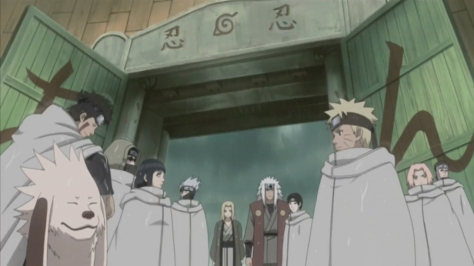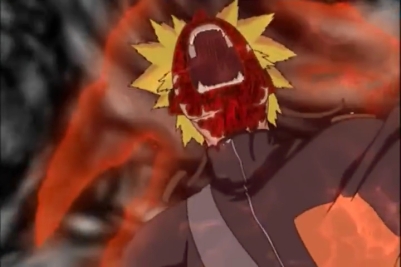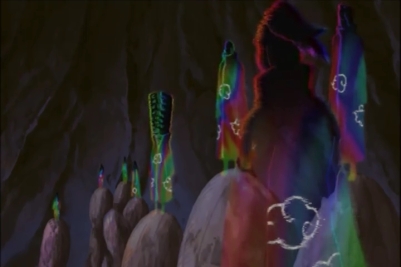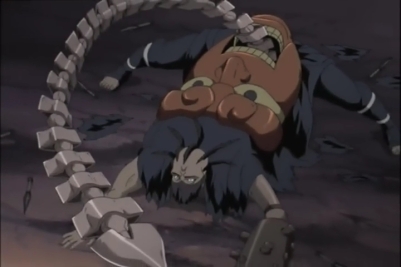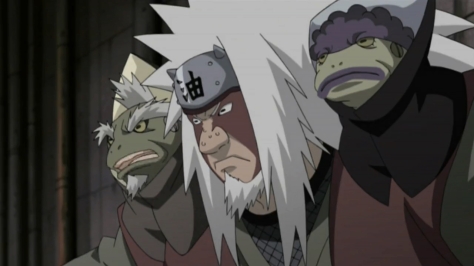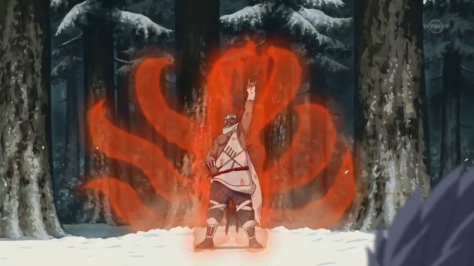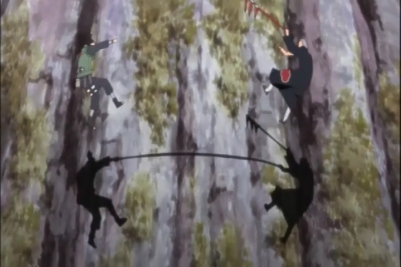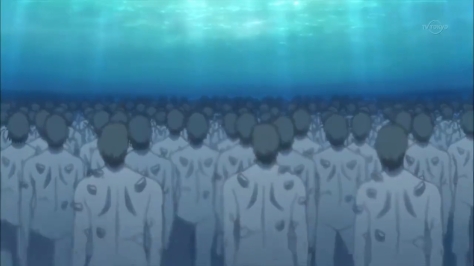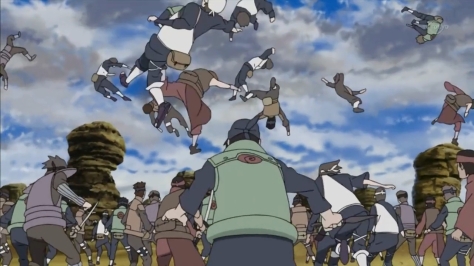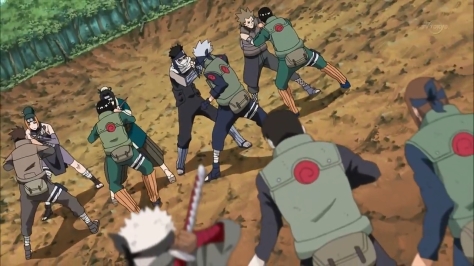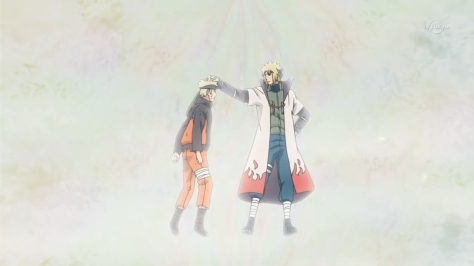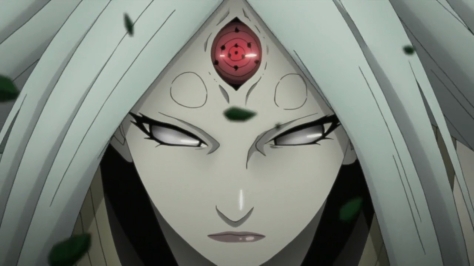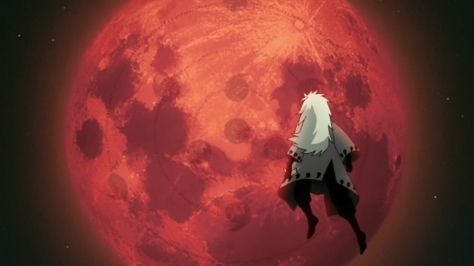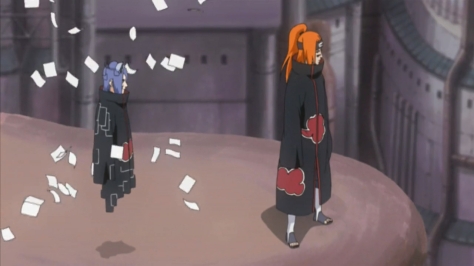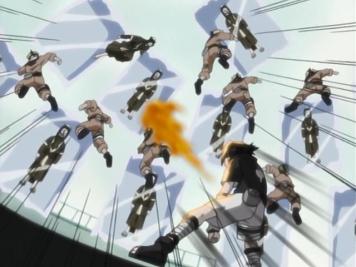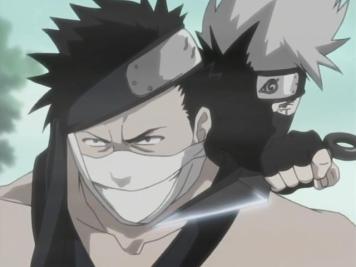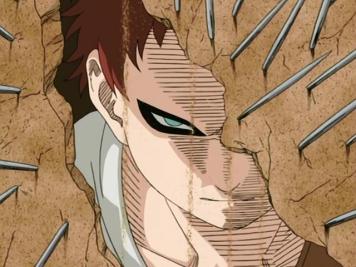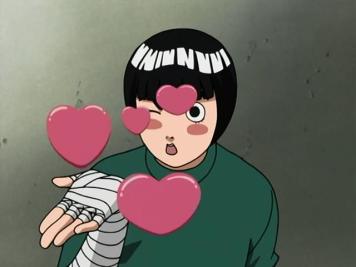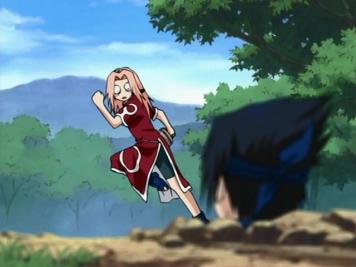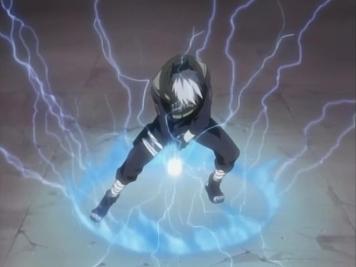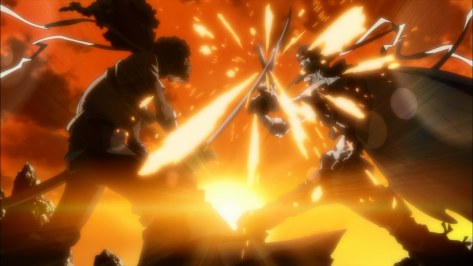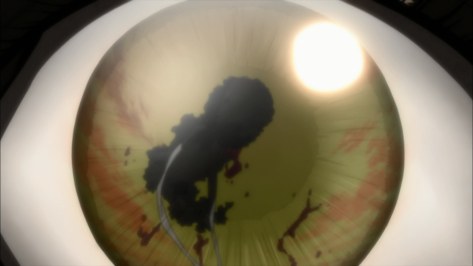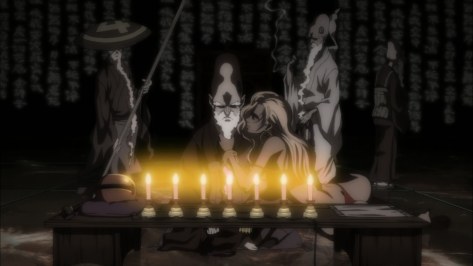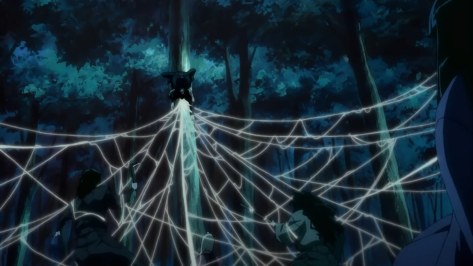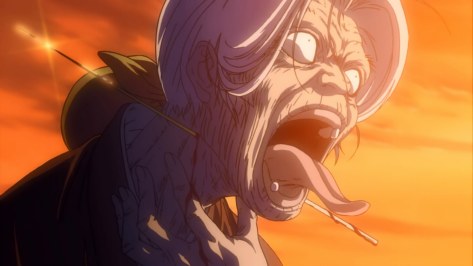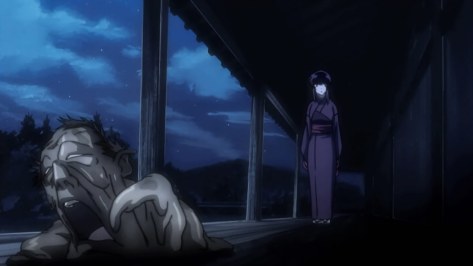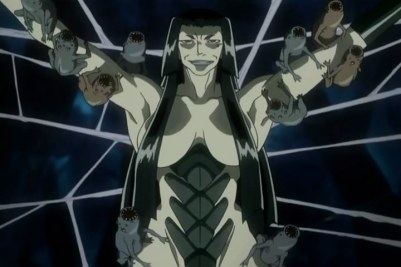Japanese Title: Naruto: Shippuden
Related: Naruto
Similar: One Piece
Watched in: Japanese & English
Length: 500 episodes (296 without filler)
Positives:
- Conclusions to plot lines established in Naruto classic
- Several excellent fights
Negatives:
- Supporting cast is less important in favour of convoluted lore
- New plot lines feel like filler
- The Great Ninja War
- Way, way too long
(Request an anime for review here.)
It is finally done. Naruto Shippuden (and The Last Movie) is no longer on my backlog. It gives me a mix of emotions – relief at having such a giant off my back, nostalgia from thinking 16 years into the past, and a tinge of sadness that it is over. It wasn’t an easy journey to reach this point. 500 episodes of Shippuden – after 220 episodes of Naruto – isn’t an afternoon’s viewing experience, especially once you hit The Wall that is the Great Ninja War. More on that later. Let’s go back. There is a lot to talk about here, so forgive the ramble and tangents.
Naruto ended with two central threads: Sasuke has betrayed the village to seek out the arch villain Orochimaru’s help and the criminal organisation Akatsuki has revealed itself to the ninja world. Shippuden jumps ahead two and a half years as Naruto returns to the hidden leaf village after a long training adventure with his perverted teacher Jiraya. The anime (unedited version) opens with a flashforward of Naruto and Sakura finally catching up to Sasuke in Orochimaru’s lair, giving the audience a taste of the major event to come. It fails to mention that we don’t reach this until Shippuden episode 51 and that it’s the most anti-climactic moment in the entire franchise. Not a great start.
Shippuden also disappoints in how it handles filler. Where Naruto padded the episode count after the main story concluded while we waited for the sequel, Shippuden inserts extensive filler arcs every second or third season.
To drag out the series further, canon episodes regularly have artificial lengthening techniques. Battle anime are notorious for static pans across a battlefield or characters’ faces. Shippuden takes it to another extreme of time wasted. I particularly remember an episode where Naruto confronts Orochimaru and only a minute of real content occurs between dramatic pauses, slow pans, and repeated lines. Replaying scenes from the previous episode is more rampant that ever, unjustified in their presence. They often repeat within the same episode in case we have Alzheimer’s. The absolute worst padding you will ever see is when Naruto’s allies remove the seals on Akatsuki’s hideout.
Let me set the scene. Akatsuki have sealed themselves inside a cave while they perform a ritual to extract a powerful demon beast from within a ninja. Outside, several of Naruto’s allies split up to remove five seals scattered around the area. Before that however, a trap summons an exact clone in ability and strength of each ninja, which they have to 1v1 before they can proceed (I thought this was the dumbest fan service idea only for it to be outdone later). These fights are just moronic. It’s repetitive and devoid of any depth – don’t forget stretching out every single shot. So, if they are fighting their exact equals, how can they win? Well, by fighting harder than themselves from before! What…? This makes one facepalm so hard that my friends and I still bring it up each time Naruto is mentioned.
Anyways, after that comes the seal removal. Each character grabs one and counts down to pull them in sync. What begins is the longest countdown in cinema history. It takes several minutes off the end of an episode, ending in a cliffhanger, only to repeat from the beginning of the next episode and take forever again.
You know what it’s like? Daytime soap operas. If you’ve ever seen an episode of Passions, Days of Our Lives, or the likes of The Bold & the Beautiful then you will know exactly what I mean.
With how much Shippuden wanted to waste my time, I opted for the “Kai” edit this rewatch. When originally watching this while current, I made it early into the Great Ninja War (Shippuden episode ~250), so I had plenty of experience with the broadcast edition. No way was I sitting through all of that unedited. Little did I know the worst was still to come.
From here on, I will be reviewing Naruto Shippuden under the assumption of the Kai edit, which follows the manga closer [almost] free of filler. There’s not much to say about the filler. It’s trash – don’t watch it.
So, Naruto Shippuden proper, how is it? I can best summarise it thusly: old is good while new is bad.
In essence, the direct continuation of story threads from the original series is successful, while new elements introduced are just crap. Interestingly, the story structure almost alternates between old and new threads, throwing you from one end of the engagement spectrum to the other.
The first arc sees Akatsuki venture into sand country to capture Gaara for the demon beast within him (their goal is a combine the power of all demon beasts). We get to meet a couple of new members, including former sand ninja and puppet master Sasori. Naruto loves to have villains that are former citizens of the place they’re attacking to add that extra emotional connection. Sasori works here, not only for giving us a great fight between three generations of puppeteers – and the only good fight involving Sakura – but also in emphasising the damage ninja life can have on oneself. It’s a good complement to Gaara’s story arc. Where Gaara fell through maltreatment from his family, Sasori lost himself when his parents died. Both grew twisted because of ninja society. A little care and consideration saved one from evil, while the other could never be human again.
Naruto’s execution of theming and tying heroes to villains is among the best in shounen anime and it makes you care for the conflict. Sure, they have a variety of interesting powers and fighting styles that make for great action – action is important to keep it exciting – yet without that emotional core, it wouldn’t stay with the audience once the battle is over. We see this time and time again. Think Lee vs. Gaara (untalented hardworking nobody vs. effortless prodigy gifted with immense power) or Naruto vs. Neji (unloved yet free outsider vs. popular and powerful slave). There are many such examples in Naruto that pack an emotional punch. The same is true for Shippuden in the better fights. The perfect example of the opposite is in the grand finale, but let’s not jump ahead just yet. My rant has some way to go.
Sasori’s partner – Akatsuki always travel in pairs – is Deidara, a loudmouth with mouths in his hands that chew special explosive clay. I hate this character. His backstory is so lame, likely thrown in place at the last minute when the author had to hit a deadline (it doesn’t come up until much later, when his story is already over, by the way). His backstory is the edgy teen who wasn’t allowed to blow things up so he went and joined Al Qaeda in protest. That’s it. And he never shuts up. Plus he ends each sentence with a “yeah” or “hm” grunt. I understand that with such a large cast you need to get creative with differentiating characters, yet you don’t need their quirk in every. god. damn. sentence. The actor never makes it sound natural by the end.
His fight with Gaara is quite good though. More of a visual spectacle. It works by contrast to Sasori’s fight, which has more story and is on a smaller scale in a confined environment. Keeping Deidara going after this arc was the mistake.
Overall, this arc is a good start and gives the [false] impression that Shippuden will maintain the same qualities that made the original series good.
Next arc introduces Sai, the replacement for Sasuke on Naruto’s team. Here we have the first example of “new” failure. His trait is being socially barren. Raised as a spy and assassin since infancy, he has no understanding of emotion or relationships. It’s a classic sad Naruto backstory, which is fine, but his arc doesn’t contribute much. He was forced into the team by the head of ninja CIA with the secret mission of killing Sasuke once found, rather than bringing him back alive. This doesn’t lead to anything. He grows a heart by becoming friends with the others before they find Sasuke, pre-empting the conflict before it starts. To top him off, the story forgets about him a third of the way through. If you were watching this week to week, his return would come as a surprise. “Oh hey, I remember that guy! What was his name again?”
That said, Sai is one of the better new additions. Most newcomers are indistinguishable from filler episode characters. The story leads Naruto to the other ninja nations, each presenting their own crew, none of which is interesting. The most important of the lot is another demon beast ninja who speaks only in rap. It is as annoying as it sounds.
After my praise for Naruto’s supporting cast in the original, it saddens to have to report on how forgettable the new guys are. Worse still, the original cast are little more than background images. Why bother creating new characters when you had such a strong cast to work with already?
This arc concludes in that flashforward I mentioned earlier. They find Sasuke, he leaves, and we are back to square one. Pointless.
Next arc shifts focus back to Akatsuki on the hunt for the next beast, two different members taking helm. Here we have one of the best fights in Shippuden: Shikamaru vs. Hidan with the scythe. I won’t go into detail here, as I don’t want to give anything away for those who haven’t seen it and there isn’t much in the way of story to dissect. Any fight with Shikamaru on stage is great for the focus on strategy over flashy abilities.
By contrast, we have the fight against his partner Kakuzu, who is a Frankenstein’s monster-style ninja with the power to stitch himself back to life. Here we see a major crack in the walls caused by one of battle anime’s worst tropes: protagonist power progression. Battle anime need to keep going bigger and more powerful to avoid stagnation with the audience. I don’t think that is necessary, if done right, though the core audience does. The only time you can deescalate is by starting a new series. A power reset each arc, like Bleach, isn’t enough. The audience still wants something bigger.
Dragon Ball Z is the classic example of why this is such a problem. Remember how when they were fighting Frieza the story impressed upon you his power and importance? Now remember how when the next villain came along, making him look like a joke, and the heroes had to grow so much stronger to beat the new guy that they could now kill Frieza with a single flick? And remember how this power was concentrated in a few main characters, making most of the allies useless in the process? Well, Naruto reaches that point. The fight against Kakuzu, which was a struggle for the team fighting him, ends with the arrival of Naruto, fresh off his latest mind-numbing training arc, who takes him out with ease. Because he’s the protagonist, the genre dictates that he must be the one to do this.
It’s not as bad as Dragon Ball Z’s issue, but it doesn’t prevent the groan-worthy ending to a fight, especially off the back of the intelligent fight against Hidan.
Next, we switch to Sasuke’s perspective as he assembles a new team. When I say new, I mean the bad new of Shippuden. He recruits a Jekyll & Hyde sort with no personality, shark boy, and yet another Sasuke fangirl. Sasuke manages to get away from his fangirls back home only for the author to go back to the same overdrawn well and give us another. You want to know the real kick in the nuts? She’s the worst of them all. Her only gimmick is being a fangirl, something the “comedy” reminds us of in every scene with her. She will have a fangirl moment (and another sort of moment, if you catch my drift) any time she sees Sasuke, even in the middle of a dramatic scene. Anyone with her as a groupie would want to shoot themselves.
Everything with these three characters is just a waste of time in the lead up to an event we’ve all been waiting for: the reuniting of Sasuke and Itachi. We can’t have this happen right away, er…125 episodes in, of course. We need another arc first.
Regardless, once it does come to a head, what can I say – it’s fantastic. Built up from the early episodes of the original, the conclusion to Itachi’s story is excellent. Surrounded by filler and padding, it is noticeable that this story was likely planned from the beginning. Its emphasis on character and emotion to deliver the final piece of the puzzle is the polar opposite of The Great Ninja War. (We’ll get to that. We’ll get to that.) This is the best of all Shippuden to me.
This great conclusion leads into another strong arc where the heroes must face the leader of Akatsuki, Pain. Similar to other great Naruto villains, Pain and his close companions follow the theme of how harsh ninja life truly is and how it can break even the nicest kid. An accident from the “good guys” created one of the most powerful villains. While a moment of love almost saved him, as it did with Gaara, it wasn’t enough to keep him from the path of pain.
He makes for a great villain. Not as good as Orochimaru or Itachi, in my books, but great nonetheless. His abilities and those of his companions are interesting. We have action, story, character, and emotion rolled into a satisfying package.
This should have been the end of it, barring the resolution of Naruto and Sasuke’s arc as a capstone. However, if you looked away from your screen at this moment and checked the episode count, you would realise we are only halfway through Shippuden.
Welcome to the Great Ninja War.
Where to begin with this one. It could warrant an entire review of its own. You know what? Let’s do it. I’m on a roll, so what’s another 1000 words?
After Pain. comes the revelation that there was another bad guy behind everything all along. (It hurts just writing that sentence. That’s the real pain.) This new villain was mentioned a few times as a backstory, though never as a relevant character to the current day. After a rubbish politicking plot that I won’t bore you with, the great nations decide to set aside their differences to team up and defeat this villain and his army of Power Rangers putty monsters. Toss aside character-focused storytelling and engaging combat in favour of two masses of bodies throwing themselves at each other.
When you think it can’t get any less interesting, the author pulls out the ultimate fan service card and episode count extender. He brings back every known character from the dead using the Reanimation Technique rediscovered by Orochimaru in the original series. A technique that barely managed two reincarnations can now summon a hundred of the best ninja with ease (remember what I said about power escalation earlier).
It was fine the first time to have two Hokage from history return to give us some lore and a bit of the “rule of cool” factor. This time, however, is just ludicrous. Outside of two or three cases, all it does is stage rematches for fan service. Even the Akatsuki members that just died come back. My level of bafflement at this entire arc is difficult to put into words. I can’t believe any self-respecting author would be okay with this.
The Great Ninja War makes up one-third of all Naruto episodes and feels like filler at least 75% of the time. This is canon filler. Even when watching this in the Kai edit, it feels as if there is no end. I get the sense that whoever was making this fan edit was also losing interest, only finishing the project out of obligation. The editing gets sloppier as you go – one episode has a scene repeat in succession (was the end of one episode and the start of the next in the broadcast release). More and more pointless flashbacks make it in. Don’t get me started on how much Shippuden uses flashbacks to pad runtime. Flashbacks should be banned from anime. The fan editor no longer bothered cutting down those slow dragged out scenes most of the time anymore. I don’t blame them. I would have given up long ago.
The Great Ninja War reaches almost Dragon Ball Z levels of terrible. As if in homage to Goku’s idiocy, Naruto also has a “Don’t interfere with my fight!” moment. Never mind that thousands of lives are on the line.
There are some good moments in this abomination. Kakashi has a good episode against a villain relevant to him, Naruto’s emotional moment meeting that character is quite touching, and Itachi is good, as always. Don’t let that give you hope though. It is small consolation for what you have to sit through.
So, despite all indications, the war does eventually come to end. And just when it seems the chute has no crap left to expel, it squeezes out one final turd. The reincarnations are dead, the masses of fights are over – surely, there is nothing left. The plumbing can’t take anymore.
Wrong!
How do I put this? Shippuden starts to become Evangelion – specifically, the End of Evangelion. Character and story is thrown aside for end-of-the-world lore and a ninja origin story. Naruto becomes the Child of Prophecy (barf); the goddess of chakra revives to wipe out the world. At one point, even the moon gets involved. A character you never cared about reveals himself as the true villain behind everything. Yeah, the guy I mentioned earlier? He wasn’t the true true villain.
What the hell does any of this have to do with anything?
Naruto loses focus, going from character driven conflicts to lore vomit with bigger and bigger abilities, constantly escalating, merely dragging it out. The supporting cast, new additions included, are relegated for bad lore.
The reasoning for any of this crap to be a part of the narrative is so flimsy you can see tape barely holding it together. It is utter shite.
Once that’s over, it wraps with the finale of Naruto and Sasuke’s conflict. After the Great Ninja War and the End of Evaruto, it’s a bloody blessing that this doesn’t fail. It’s not great, though it’s not bad either. The finale is of much better quality, particularly in visuals, though it feels weird coming after so much filler and in how it ignores much of what just happened.
Some might say that The Last Naruto Movie is the true end to the series. It isn’t. The movie’s sole purpose is to sell you on the idea of the Naruto and Hinata relationship. Remember when that was a thing they never developed at any point? Naruto goes from ignoring Hinata like always to suddenly confessing undying love after a stint through this extended filler episode they call a movie. There is no foundation to this relationship. I don’t care for it whatsoever.
And that’s it. That’s Naruto concluded with my far too long tirade, a few thousand words over the limit. What do I think of it overall? Well, the parts I like are great, notably the original series. It has some of anime’s greatest fights, most complex villains, and best supporting characters. But there is also a lot of baggage weighing it down. Shippuden should have just been a conclusion to Itachi, Orochimaru, Sasuke, and Akatsuki (as first established, not what it became to justify the Great War). 150 episodes, maximum, to cover the golden content in this 720-episode bloat.
I don’t regret my time with this series. I do wish I could recommend it though, but in its current state, I can’t ignore the problems that come at the end. At most, I would recommend watching from the original series until the conclusion of Pain’s arc, in the Kai edit. No one should have to go beyond that.
The real question is whether finishing Shippuden has motivated me to start on Boruto. No. The answer is no. Naruto is done in my life.
Art – Medium
Like most long-running shounen anime, Naruto: Shippuden is inconsistent in its art. You can have episodes with brilliant, fluid animation and proper cinematography. You can also have episodes filled with static shots and character cutouts sliding across the screen. Character designs have lost detail to make them easier to draw and animate.
Sound – Medium
The music still shines as one of the best collections amongst shounen anime. The dub isn’t much of an improvement over Naruto classic. Those that were great before are still great – Naruto’s English voice is still bad to me. The writing has taken a serious dive, particularly in the new plots.
Story – Medium
Naruto and co. continue their search for Sasuke as they fight foes old and new. The old ongoing threads are good, while new introductions to the story are filler.
Overall Quality – Medium
Recommendation: For Naruto classic fans only. Even if you watch the Naruto Kai edit, this is still a gargantuan anime that I can’t recommend to anyone not already invested from the original series. There are several satisfying conclusions for fans, however.
(Request reviews here. Find out more about the rating system here.)
Awards: (hover over each award to see descriptions; click award for more recipients)
Positive:
Negative:

